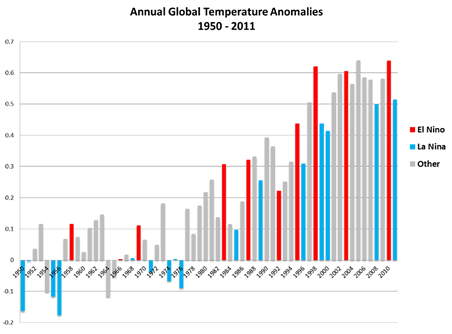You cannot claim to be interested in global warming unless you are fascinated by a rather obscure climate variable. No, not the climate sensitivity (that comes in at a close second place) but the Global Mean Temperature (GMT). This variable has come to define the science of climate change and although no one can actually agree on how to calculate it, every January there is a flurry of excitement as statisticians proclaim the GMT for the previous year. The year 2011 was the ninth, tenth or perhaps the eleventh (depending on which analysis method is your favourite) warmest year on record. The most likely reason for 2011 failing to challenge 1998, 2005 and 2010 on the top of the global warming leader board is, apparently, a result of a fairly pronounced La Niña. As NOAA points out (see graph below) 2011 is the warmest La Niña year on record which is notable as La Niña years are typically associated with a cooler GMT. So with model outlooks suggesting a weakening of the La Niña over the coming months, is it possible that NASA’s prediction that “it is likely that 2012 will reach a record high global temperature” will be a reality? NASA also note that “the frequency and magnitude of extreme events could reach a high level in 2012” so maybe the Mayans were onto something! As the tagline of the blockbuster film 2012 states… “We Were Warned”.

Fortunately, I am not paid by CSAG to make predictions regarding the chances of a record global temperature in 2012. Instead I can resort to the relative safety of speculating what 2012 might bring for the world of climate change policy and climate science research. The centerpiece of the 2012 conference calendar is the Earth Summit 2012 (or Rio+20) meeting to be held in Rio de Janeiro in June. The issue of climate change and how the UN has managed climate negotiations over the past twenty years since the 1992 Earth Summit is sure to be high on the agenda. It is not clear whether or not heads of state will be attending the meeting in Rio but those interested in climate policy, and particularly the future of the UNFCCC, will be keeping a close eye on developments. As a pre-cursor to the Earth Summit 2012, a conference titled “Planet Under Pressure” will take place in London in March. The conference aims to “provide a comprehensive update of our knowledge of the Earth system and the pressure our planet is now under“. It is hoped that researchers and businesses will come together at this conference to showcase sustainable solutions to combat the various environmental challenges that we are faced with and generate a sense of optimism which can encourage policymakers at the Rio meeting to be ambitious in committing nations to address global sustainability issues. I will be attending the London meeting so keep an eye on this blog for updates during the conference.
For climate scientists, 2012 offers another opportunity to submit scientific contributions for the latest IPCC report. The deadline for Working Group I contributions is July 31st but those working in impacts, adaptation or mitigation solutions can relax as the deadline for Working Group’s II and III isn’t until January 31st 2013. Here at CSAG, we are hoping for much better representation from African research institutions in the AR5 report compared to previous assessment reports. One of the aims of the CORDEX project is to produce a number of papers regarding African regional climate change information for inclusion in the AR5 report to provide a sound scientific basis for supporting adaptation decisions across Africa. A paper writing workshop will take place here in Cape Town at the end of February to enable authors from different institutions to come together and work on their contributions.
Finally, as is traditional before Christmas, the year will end with a gathering of negotiators repeating the words “urgency” and “common but differentiated” at the annual UN COP meeting. The big question everyone is asking this year is what on earth they will call the inevitably meagre policy developments made in Qatar. My money is on either the “Doha Dossier” or the “Doha deliverables”. Any other suggestions?
Erica
I also liked the Copenhagen Cha-Cha? “one step forward, three steps back, run in a circle making squawking noises, and then point the finger of blame at somebody else on the dance floor.”
Joseph
> I think the fixation on these quantities is a problem for climate communication and we should start phrasing things in terms of more meaningful quantities that people can actually understand and feel connected to.
Agreed, though the use of global mean temperature in mitigation policy (e.g. 2 degrees below pre-industrial) is probably more useful than any other climate variable to set tangible policy targets for negotiations.
Glad you like “Doha Dossier” – I might get legal copyright for that!?
Erica
I find both “climate sensitivity” and “global mean temperature” slightly odd concepts. Neither is very well defined, making the scope for argument almost limitless, and neither has much to do with the actual impacts of climate change. They also mean nothing whatsoever to the man on the street. I think the fixation on these quantities is a problem for climate communication and we should start phrasing things in terms of more meaningful quantities that people can actually understand and feel connected to. If that means greater uncertainty… fine.
Doha Dossier sounds good, although I think Rio+20 is probably the one to watch this year. If that’s a damp squib, then nothing will happen in Doha. If Rio goes well and gets somewhere, Doha will just be footnotes.